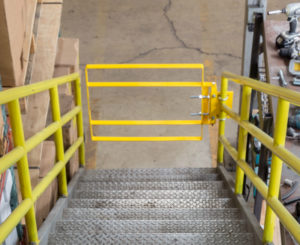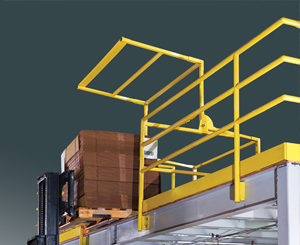
When you’re responsible for your workers’ safety, you do everything you can to ensure that your workplace is OSHA compliant and geared towards passive fall protection. We know you work hard to keep everything in smooth operating order for your employees, and that’s why we’re providing this brief guide to fall safety.
From adequate illumination to the perfect safety gate systems, all it takes is one overlooked detail to become non-compliant with OSHA’s guidelines. Let’s look at some signs that your facility needs a fall safety evaluation—and what to do about it.
Sign # 1: Clutter & Untidiness
Clutter, disorganization, and messiness in the workplace might be a sign that you need a fall safety evaluation. Carelessly-placed items can present a trip hazard even for your most seasoned and careful employees. Spills and sticky floors can present hazardous conditions and contribute to accidents. To optimize your fall safety standards, do the following walk-through with OSHA’s sanitation standards in mind:
- Make sure the floors in all of your workplace areas remain dry. Emphasize eliminating slick conditions on elevated surfaces, or near important safety gates.
- In keeping with OSHA’s guidelines, check floors in elevated areas for “nails, splinters, loose boards, and unnecessary holes and openings.”
- Make sure no waste receptacles are leaking in elevated areas (or otherwise presenting a trip hazard).
- Ensure that there is no clutter, stacked materials, or blockages which could represent a hazard to your workers — especially near safety gate areas.
Sign #2: Untrained or New Employees
“The employer shall provide a training program for each employee who might be exposed to fall hazards. The program shall enable each employee to recognize the hazards of falling and shall train each employee in the procedures to be followed in order to minimize these hazards.” — OSHA 1926.503
Bringing in new employees can help reinvigorate a workforce and keep the momentum going among your crew. However, recent hires could also be a sign that you need to do a fall safety evaluation — starting with training. Do your new employees understand how to operate safely around your passive fall protection systems? Can they easily operate each swing gate? Are they trained to recognize trip hazards and unsafe conditions in the workplace?
Remember, training doesn’t only apply to new recruits: even your most seasoned staff might need a refresher course on fall safety. Try to schedule training at set intervals every year so that each member of your staff — from new employees to seasoned site supervisors — is up to date and understands their role in prioritizing fall safety. This goes for people who are not your employees as well, and make sure that only authorized persons are allowed on elevated platforms.
Sign #3: Unfamiliarity with Fall Protection Specifics
If you’re unfamiliar with some of the fine-print details of OSHA’s fall safety guidelines, it might be time for a fall safety evaluation. According to OSHA’s fall protection guidelines, employers need to ensure that all employees who work on surfaces with unprotected edges that are 4 feet above a lower level need to have fall protection systems in place. Obviously, this applies to all elevated platforms, but you need to take special care with the following circumstances:
- Stairways. At your workplace, stairways probably get a lot of traffic. Keep in mind that OSHA requires stairways to be protected by a fixed guardrail system on the exposed sides.
- Ladderway. Similarly, OSHA stipulates that all of your employees are protected from falling into a ladderway floor hole or platform hole with the use of both a guardrail system and a toe board system on the exposed sides. At the entrance to the ladderway, you should use an OSHA-compliant safety gate.
- Runways. Similarly, fall protection is required for employees who use runways or other walkway systems in their work day.
Mezzanine. Your employees must be protected with OSHA-compliant safety gates on the mezzanine.
- Pits. Take extra care when your workplace has any repair pits, service pits, or assembly pits. If you do not utilize a guardrail system for pits less than 10 feet deep, you will need to use a system of floor markings and stanchions to prevent incidents.
- All Access Ways. When using guardrail systems around access ways, you need to ensure that the guardrail system has a self-closing swing gate that swings away from the access hole.
When in doubt, review OSHA’s guidelines on passive fall protection and evaluate your work space for any stairways, ladderways, access ways, runways, or other exposed edges that don’t have fall protection systems in place.
Sign #4: Inadequate Lighting
“Construction areas, aisles, stairs, ramps, runways, corridors, offices, shops, and storage areas where work is in progress shall be lighted with either natural or artificial illumination.” OSHA 1926.26, Subpart C
Especially during rush times like the impending holidays, it’s easy to overlook details that seem insignificant. For example, to provide adequate fall safety for your employees, it’s pivotal to provide adequate lighting.
If it’s been some time since you have looked into the illumination of your workspace, it might be time to revisit this important safety aspect. Are all work areas adequately lit? Are there any areas where dim-lit conditions could cause a potential fall or hazard? Quality lighting not only protects your workers from accidents made in dim conditions but has actually been linked to boosted employee productivity and morale.
Sign #5: Out of Date Fall Protection Systems
Standards change over the years. Technology improves, and OSHA works harder to ensure accidents don’t happen at work. As a result of these (generally positive) facts, the fall protection systems you’ve instituted in the past might be out of date. Use this opportunity to brush up on OSHA compliance so you can be better prepared for next time. Here are some common issues we’ve seen:
- Out of date swing gate systems. If you last purchased your swing gate or safety gate systems many years ago, and they weren’t top-notch quality, you might be seeing some signs of wear and tear. Check for signs of rust, busted screws, jagged edges, or other signs that it’s time to start looking for a replacement.
- Chains instead of a safety gate. Some workplaces use chains instead of a swing gate or safety gate. Safety and Health Magazine describes how chains are less protective of your workers than self-closing safety gates.
- Improperly installed systems. It’s not just the equipment: it’s how it’s installed. If you are unsure if your passive fall protection system was installed with the greatest care possible, it may not be up to par.
From close calls to a cluttered workplace, you need to be able to read the signs that you are in need of a fall safety evaluation. Though it sounds like a hassle, it’s going to prevent possible injuries in the long-run, and ensure that you stay compliant with OSHA’s many guidelines. At Fabenco, we’ve spent years designing and providing the very best in passive fall protection. If you’re interested in learning how we can help you achieve your safety goals, please reach out today.




















